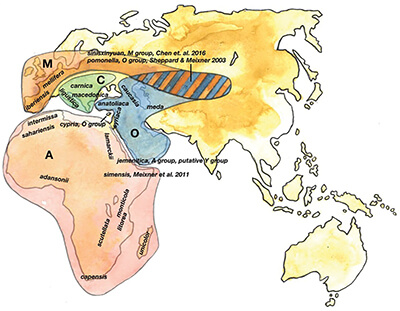
I was a young Assistant Professor, dark-haired, my PhD merely weeks old when I arrived, briefcase and 35-mm slide carousel in hand, for my first lecture to a beekeeping club in London. As soon as I entered the lecture hall I could tell something was up. There was a buzz of agitation in the air. Tight knots of tweedy, middle aged men were gathered here and there engaged in heated conversation, faces red, fingers jabbing in the air. I paused for a moment uncertain, my youthful confidence wavering. Somehow word got around that “the speaker had arrived,” and within minutes I was mobbed – those same angry red faces now aimed at me.
“Tell us,” their spokesman demanded, “Is Apis mellifera native to Britain?”
I was utterly unprepared for this. I stuttered and hem-hawed. I could see my positive first impression draining from their expressions. But otherwise the Englishmen were motionless, tense as a bowstring, awaiting my answer.
“Um,” I ventured – desperately wishing I’d paid more attention to honey bee biogeography for my oral exams – “Yeah, right. They’re native to Britain.”
Instantly it was if the clouds parted and the sun returned. Frowns melted into smiles. They clapped me on the back and drifted away, nodding to one another with satisfaction.
What was that all about, I wondered. And when I put the question to words I learned that the speaker immediately before me, a bloke from the British Museum, had ventured the preposterous notion that Apis mellifera was not native to Britain at all but was instead a relative newcomer, imported there by the Romans.
In any case, I left that experience with new confidence, glad to learn that my Louisiana PhD could be so useful at making the world right again. It was my first exposure to the passionate loyalty that British beekeepers, and Europeans in general, feel toward their local bee biotype.
I have long since been confirmed in my conviction that beekeeping is a passport to the world. A keeper of honey bees can travel anywhere Apis mellifera is kept, open a hive, and immediately feel at home. Details may differ – things like hive parts and dimensions, and sometimes dramatically so. The bees will differ too, sometimes dramatically – especially for keepers of European bees experiencing the African variety for the first time. But the foundational biology and life strategies are largely the same, as are the handling skills and beekeeping paraphernalia required for human management.
But a beekeeper traveling to Europe, Asia, and Africa can witness something we in North America, South America, or Australia never can – and that’s the races of honey bee living in a high state of adaptation in the native ranges in which they evolved. And for the taxonomic purists among us, now’s a good time to point out that generic names are capitalized and italicized, as in Apis, whereas specific names are lower case and italicized, as in mellifera. For those species with recognized subspecies or races (not all do), the subspecies is indicated as a third name, also lower case and italicized; thus, for example, with the Italian honey bee we have Apis mellifera ligustica, and with the northern European honey bee we have the curiously redundant Apis mellifera mellifera.
The natural range of the western honey bee Apis mellifera spreads across all of Africa, the middle East, Europe north to the Arctic Circle, and almost a quarter of Asia. Across that vast fraction of Earth’s terrestrial surface, this one species has differentiated, by my count, to no fewer than 32 recognized subspecies or races, 23 of which are mapped on Fig. 1. Moreover, these subspecies cluster naturally, based on morphology and molecular data, into 4 or 5 lineages which represent shared evolutionary history and migration patterns: the O group representing subspecies from the Middle East and west- to central-Asia; the A group constituting subspecies in Africa; the M group including subspecies from northern and western Europe and eastward into central Asia; and the C group representing subspecies from southern and eastern Europe. Some authorities recognize a 5th lineage, Y, from northeastern Africa and the Middle East.
In a pattern consistent with our earlier discussions about evolutionary descent, for example the corbiculate honey bee ancestors we addressed in March, our reconstructions of honey bee genealogy are partly technology-dependent. Early studies were limited to focusing on geographic distributions and shared morphology of current and fossil species. Later studies take advantage of improving genomic technologies to include shared genes in phylogenetic reconstructions. And finally, the enormous quantity of molecular data generated by the genomics revolution has engendered the practice of depositing data in publicly-accessible banks from which other scientists can draw for their own reconstructions.
In this manner, newer phylogenetic studies can be privileged over older ones for the simple reason that they can draw from more data and offer better resolution of thorny relationships. Increasingly sophisticated statistical tools are available for discovering networks of shared genes, nearest genetic neighbors and most parsimonious genetic reconstructions, all of which means we are living in an age of unprecedented power to understand and reconstruct natural history. Another pattern that emerges with more recent reconstructions is a messier history. It’s as if the more orderly earlier models were biased with human expectations of “what logically should be,” whereas later models with their greater powers of resolution are better at surprising us with “what actually happened.”
In our present case – the origin of Apis mellifera and subsequent evolution of its many subspecies – the existence and makeup of the 4-5 major lineages M, C, A, O (and possibly Y) have stood the test of time. Originally constructed in the 1970s based on …


